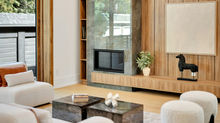Solving 5 Furniture Shopping Pitfalls You Never Knew You Had
- Dafna Adler

- Jan 18, 2020
- 3 min read
Updated: Sep 26, 2020

Have you ever had the experience of buying something that looked so good at the store but did not work out at all when you got it home? Consider this scenario: your best friend has a keen eye and great taste. Why not go shopping with your friend to create a space you’d love to live in? Well, as an interior designer, I’ve seen it all before, so I’d like to give you the inside scoop on some snags that furniture shoppers often run into. I’ll also share how we fix or prevent them.
1. It’s Out of Proportion
When you see a living room or any room layout in a store, you are not looking at the same dimensions of your room at home. Furniture that fits well together in a store setup may be oversized or out of proportion to your space. By contrast, a designer starts by creating a floor plan that provides you with the size and dimensions of the furniture to aid in proper room placement.
2. The Lighting Is Different
Another issue is the lighting in the store. Under the very high ceilings or harsh lights of a commercial space, fabrics and colors may look different. Texture may not be as visible, and some tones will be off color. As a result, you might end up with some rather uncoordinated furniture. On the other hand, a designer can bring fabrics and samples to your home for you to see in person, in your space, with your lighting. If you like a fabric, the designer may recommend changing the lightbulbs or placement of the lights to make the furniture look even better in the room.
3. Whose Advice Is It Anyway?
Another key consideration is the advice you get from the salesperson. Design consultants in department stores are paid on commission for any item they sell, whereas an interior designer benefits most from your satisfaction. Free from store restrictions, a designer can purchase from trade sources that people outside the industry may not know about or cannot utilize. As a result, you can often get better pricing when you hire a designer.
4. Quality Unknown
We’ve all had the experience of buying something or, perhaps even worse, receiving a favorite item as a gift that wore out before its time. It can be like that with store furniture, too. Instead, an experienced designer can advise you on the quality of the items you are considering and can shop for any item. Not all sofas or tables are created equally or made the same way. With expert advice, you can decide what amount you are willing to pay for the level of quality that’s important to you.
5. Your New Furniture Could Serve You Better, If Only…
Have you ever felt uncomfortable in someone’s home without knowing why? This can happen even when you feel at ease with the people in it, and even if you like all their furniture. You very well might be picking up on the bad vibes of a space that isn’t being used as well as it could be. For instance, when planning a space, an interior designer considers the floors, walls and ceiling, overall lighting, window treatments, and accessories. Any or all of these variables can affect the feel of a space or the flow from room to room. Sometimes, the furniture may not be quite right for a space, and other times, it may need to be rearranged or moved to a different room. An interior designer has the education and experience to provide you with the best advice for the overall look and feel you wish to achieve in your home.
Aesthetics, functionality, proportion, taste: all of these factors matter in creating a space that reflects your style. Let’s face it: you need furniture that fits your lifestyle, in rooms that you’re happy to call your own. Call Interiors By Dafna Adler today for a consultation: (516) 234-5425, or book a complimentary discovery call.






































Comments